We start our morning with a short (about 30 minutes) flight north to Axum. A little after 10 am, we are met at the airport by our implementing partners, Glimmer and Relief Society of Tigray (REST). REST has been one of our most valued on-the-ground partners in Ethiopia since the beginning of W2T…..we implemented our first 12 projects with REST/Glimmer in 2008 near Axum. Since then, W2T has funded over 120 projects with REST, including the last batch of 70+ projects that were approved for funding in late 2011. All of the projects that we will visit over these next two days are part of this latest funding group.
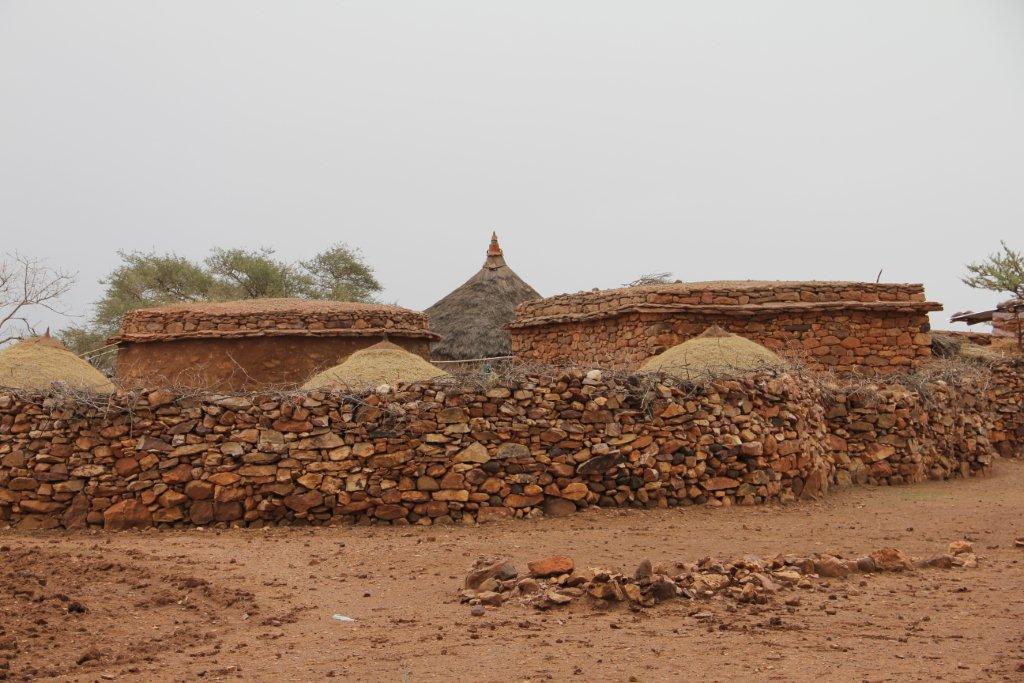
Some of the first things you notice when leaving the airport is the red dirt and red rocks….red rocks are everywhere! Also, this area is more arid than Lalibella and Gondar. It is only logical that the local Tigrayan people would take advantage of this plentiful natural resource. Houses for the farmers and for those of the villages are almost always built from the red stones….fences around the house and farm too. The Tigray region has some great stone masons! The picture above shows a typical farm house in this region, with a neat stone fence, two well made houses and several stacks of hay.
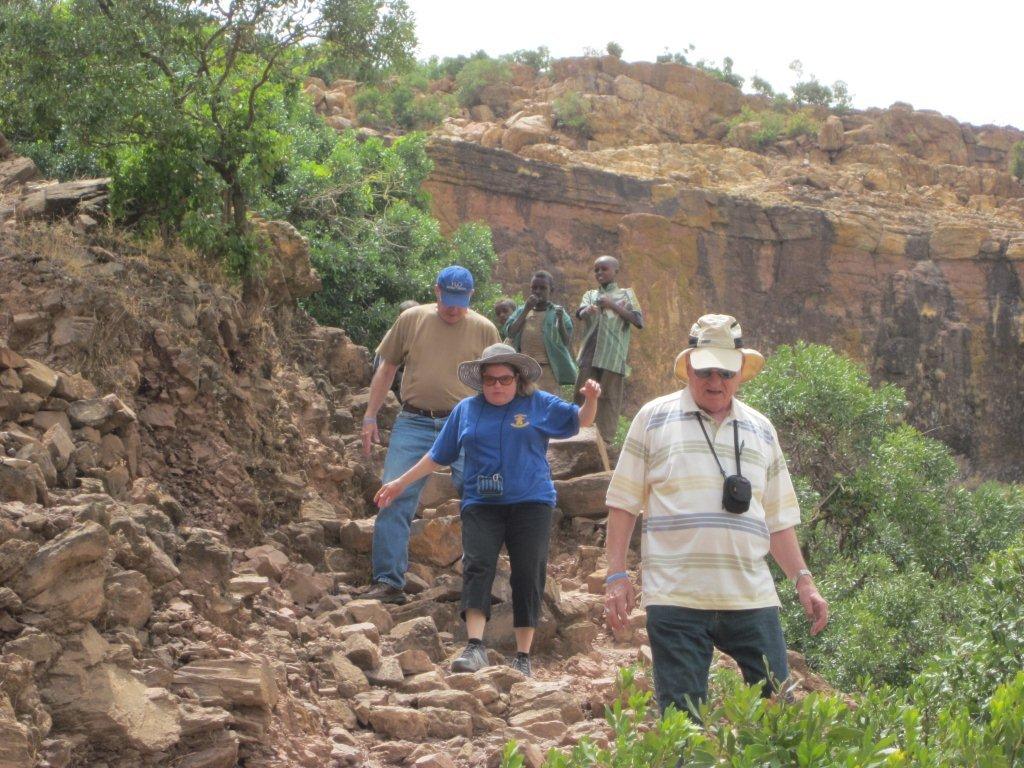
After landing and connecting with our partners we head directly to the field to visit some well projects in process. All three of the sites planned for today are hand dug wells (HDW). The first site we plan to visit is Sagla Mai. As our vehicles draw to a close, we instantly see that we are high on cliff, overlooking a deep valley. Of course, the project site is deep in the valley….while it looks straight down, Danny from REST assures us that there is path. Immediately our group of six is down to 4 and we start down the hill. A little over a third of the way, our group of four is down to 2, as we all start to realize “Oh my gosh, we have to walk out of here, all uphill too!” As we hear the community singing and clapping in the far distance, Jan and Dick continue the trek to greet the community.
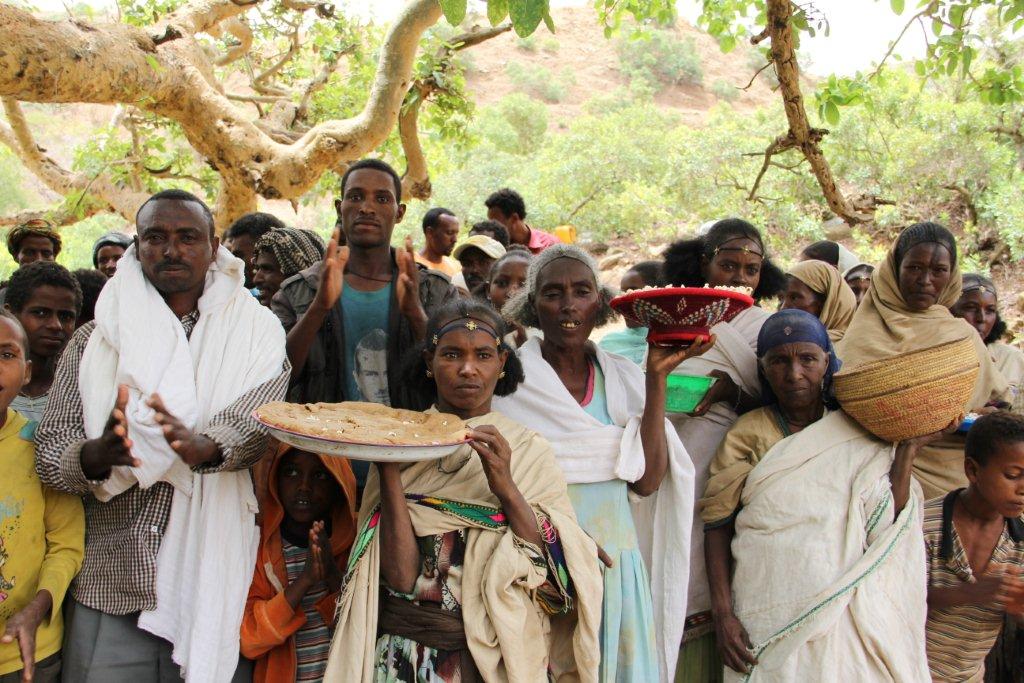
The total walk takes about 45 minutes, but it was worth every step. We are met by about 125 of the locals from Sagla Mai who were expressing their gratitude by music, song and clapping. They also brought ambasha bread, popcorn and honey to spread on the ambasha to share their gifts with us a way of expressing their gratitude.
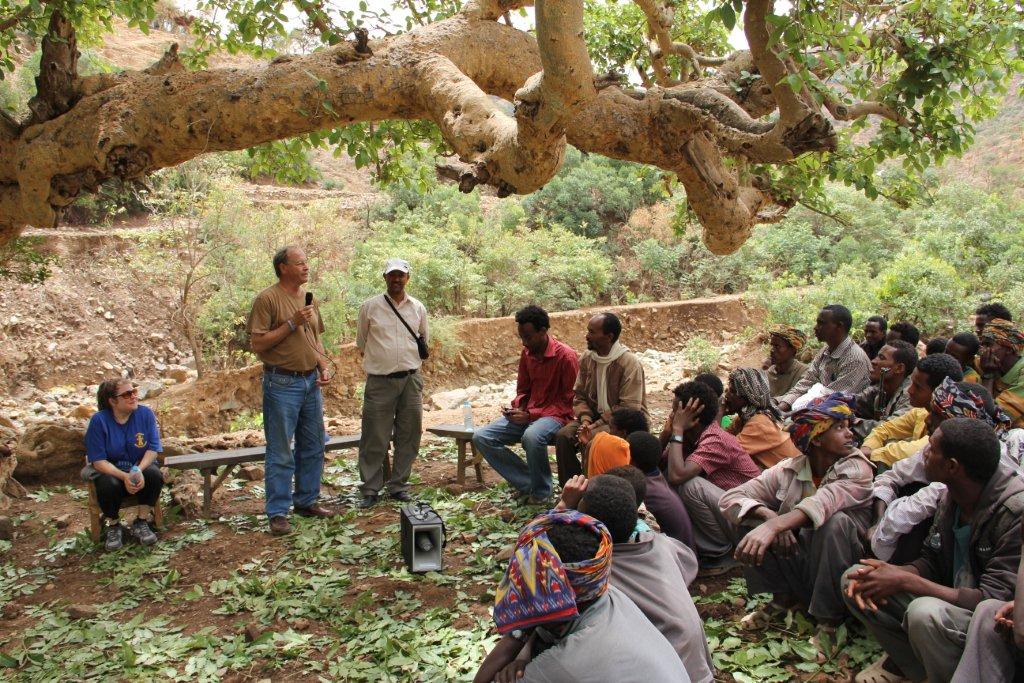
After visiting their well project in progress, Jan and Dick were invited to sit with the community to share expressions of gratitude and thanksgiving. The spot the community had picked was under a beautiful, old, weathered tree. In the picture above, you can see one of the large branches as it over hangs our meeting while we share greetings.
The trek back up the hill was something else. It takes well over an hour and seems straight up (of course it is not). Jan and Dick finally reach the top, exhausted and gasping for air. It was there that we learn from Gebreselassie’s (from Glimmer) GPS that our trip was almost two miles with an elevation change of over 450 feet (that’s a 45 story building folks!)
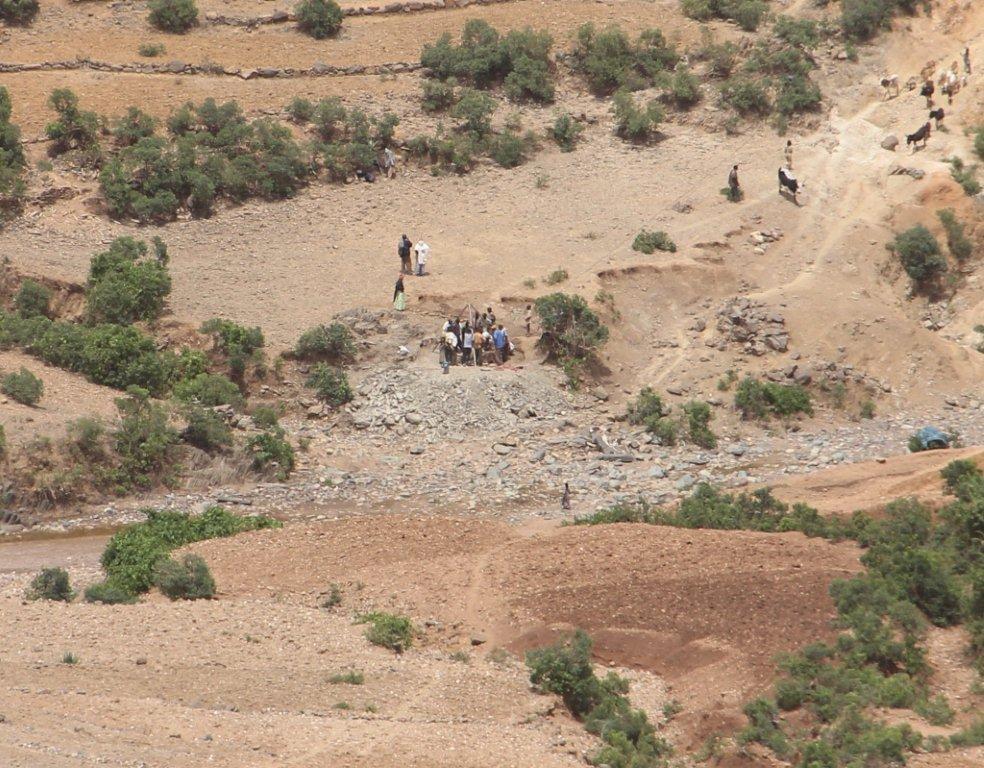
After gathering our energy, we pile back in the vehicles to head to second site, Mai Kado. As we pull to a stop at the edge of a cliff, we realize it is definitely “same song, second verse”. We also learn from the REST technician for this site that they are preparing to blast rock in the bottom of the well shortly. No one is up to the two way journey, so we perch ourselves on edge of the cliff to watch for the explosion. After a few false starts, we hear the loud explosion and can actually hear rocks falling around the well site, deep in valley. If you look closely at the picture above, the well site is in the middle, where the cluster of people are peering into the well, just before the blasting.
After seeing the blast, the group decides to split. Dick and REST/Glimmer team will visit another water project site, Mai Daero and rest of the group goes with Jim and Alem to visit Selekleka, the community where Jim and his wife Carolyn served as a medical missionary over 50 years ago.
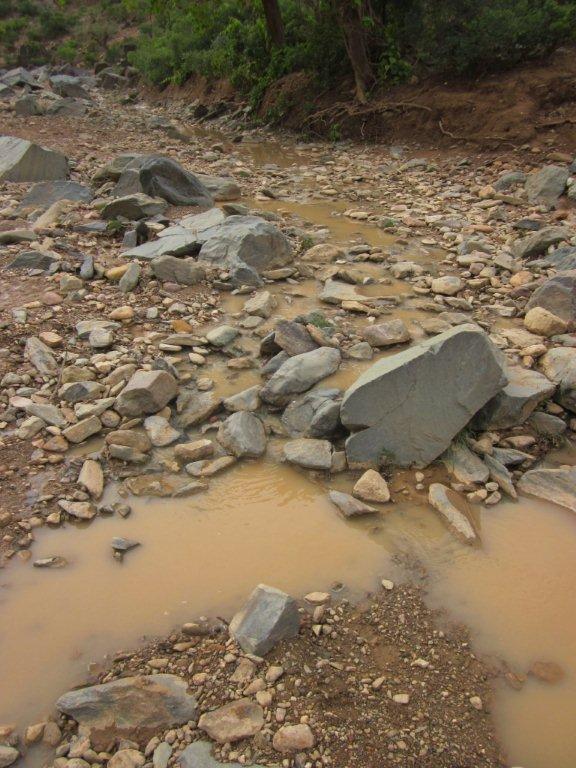
For Mai Daero, we are more fortunate as we are able to get within about ½ mile, before starting to walk. As we reach that spot, the community is waiting for us with flutes, songs and flags to lead us to the project site. As the near the project site, we have to cross over the river bed shown above. This is where the community is currently gathering water. Of course the water is contaminated, because it is shared between the people and livestock, and there is not much of it even though the rainy season is just starting.
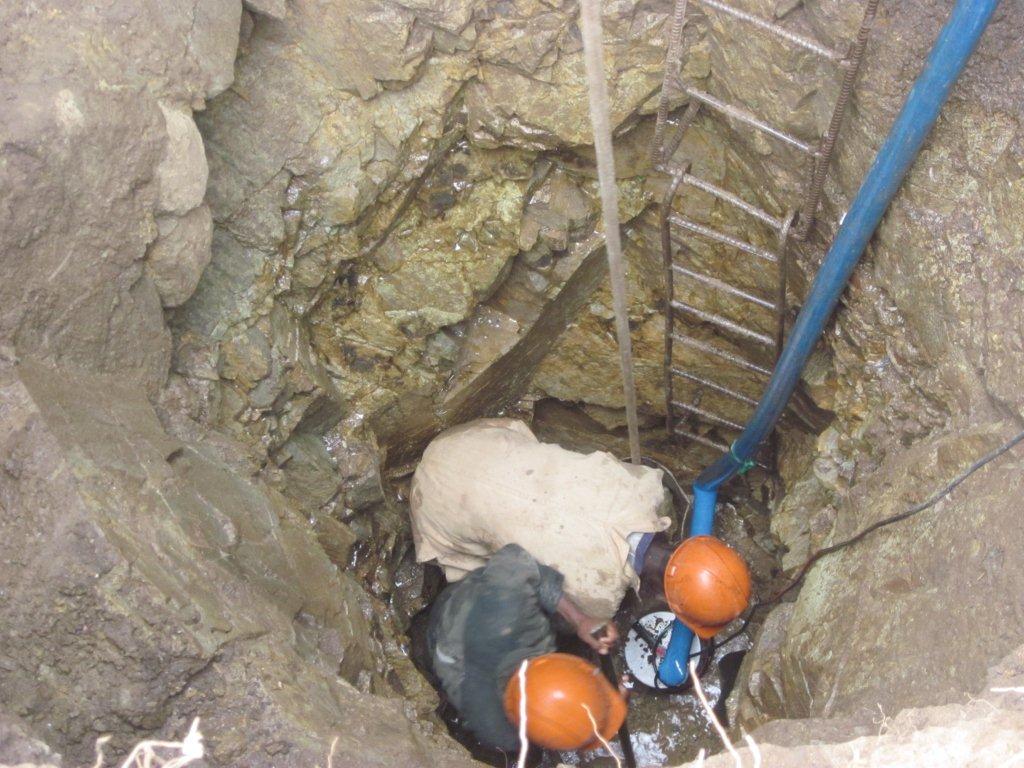
When we reach the Mai Daero project site, there are two workers in the bottom of the well (about 20 feet deep), working to remove stone and dirt that they have chipped away. A pump/generator is running nearby, pumping water out the well, because they have already hit several underground spring that will feed the well. This is a great sign that the community will have plenty of water.
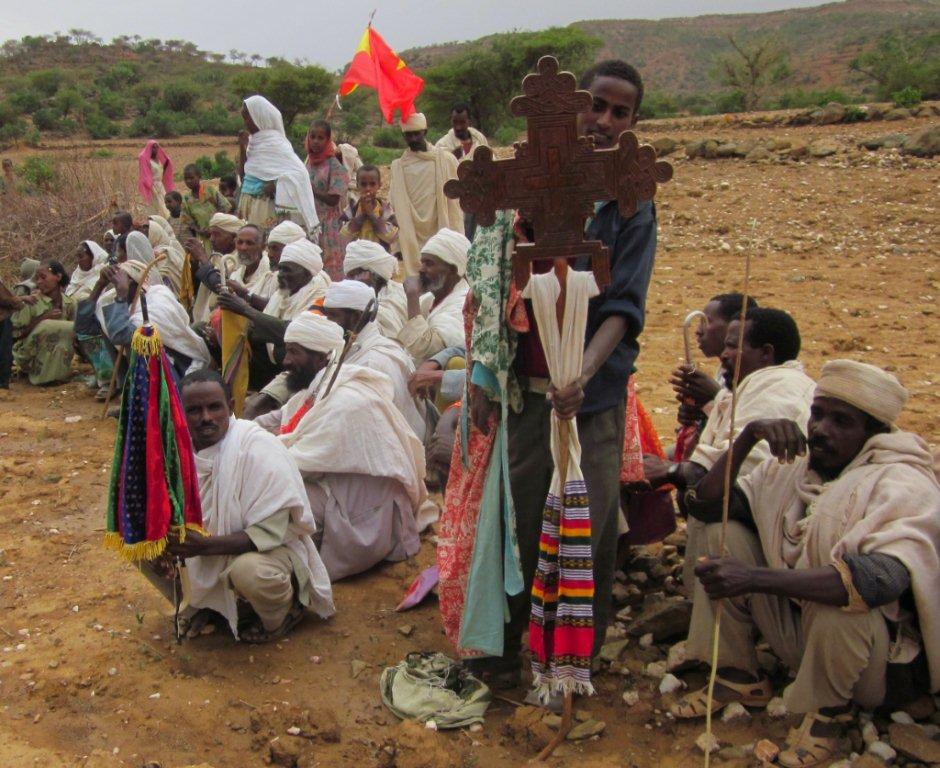
After inspecting the well together, the community leads us to the shade for some discussion and the expression of their gratefulness by sharing some ambasha bread, popcorn and a local snack made from a roasted small, soft lentil. As part of the welcoming group from Mai Daero, there are about 10 Ethiopian Christian Orthodox priests on hand as well.
As it seems this time of June, the dark threatening clouds have gathered, and the smell of fresh rain is in the air. Our drivers suggest we make our way to higher ground and better roads before the rain comes.
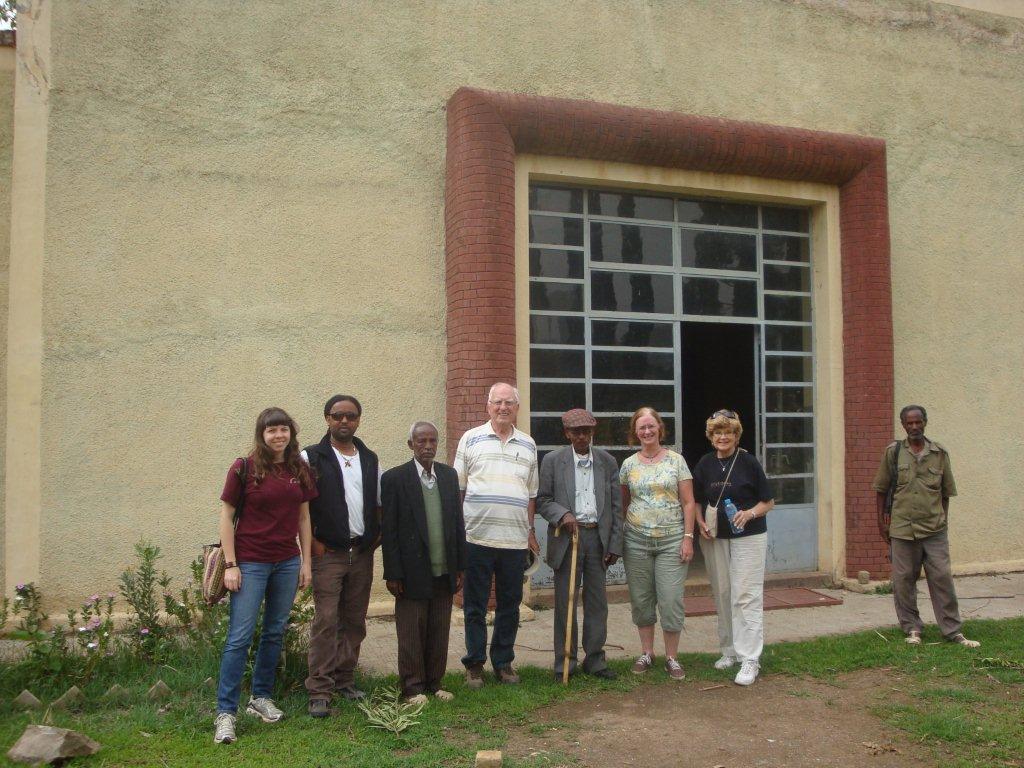
While Dick visited the last project site, the rest of the group traveled on to Selekleka, to visit the mission station where Jim and his wife Carolyn worked over 50 years ago. Along the way, the team picked up two of Jim’s friends who used to work for the ALC mission station just outside of town. Tsehaye used to work for the Sorensen’s when they lived here, and when Jim started the clinic and hospital. Aligas used to work as a carpenter at the mission. The school at the mission station is still being used and run by the government. But, Aligas was quick to say, “But, we still call it the Mekane Yesus school.” Sad to say, the large U-shaped building which used to house the clinic, hospital, chapel, and four living quarters for missionaries, is standing idle. Aligas told us that “they” have now they have the water running again. We could not ascertain what that might mean for any future activity. The trees are beautiful now, almost covering all the windows in the place, but the orchard of orange trees is slowly dying out because no one cares for them. It was good for Jim to see his friends, but sad that the place remains idle.
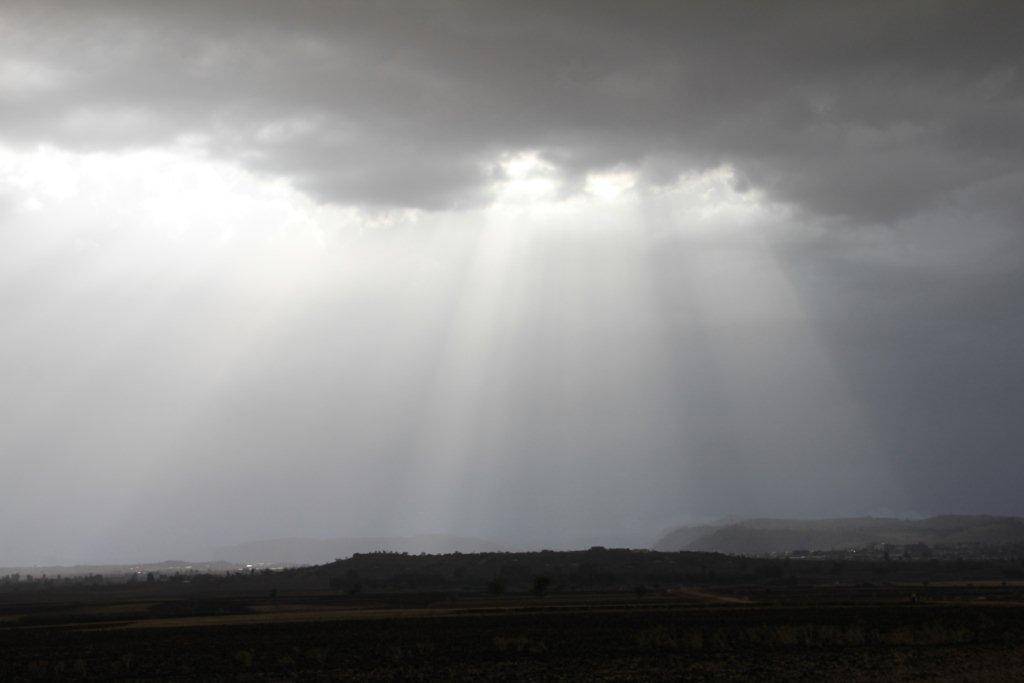
As we make our way back to Axum from the field, we are greeted by two of God’s great blessings, sunshine and rain, happening at the same time over the city of Axum. The perfect ending to a great day!
We start our morning with a short (about 30 minutes) flight north to Axum. A little after 10 am, we are met at the airport by our implementing partners, Glimmer and Relief Society of Tigray (REST). REST has been one of our most valued on-the-ground partners in Ethiopia since the beginning of W2T…..we implemented our first 12 projects with REST/Glimmer in 2008 near Axum. Since then, W2T has funded over 120 projects with REST, including the last batch of 70+ projects that were approved for funding in late 2011. All of the projects that we will visit over these next two days are part of this latest funding group.

Some of the first things you notice when leaving the airport is the red dirt and red rocks….red rocks are everywhere! Also, this area is more arid than Lalibella and Gondar. It is only logical that the local Tigrayan people would take advantage of this plentiful natural resource. Houses for the farmers and for those of the villages are almost always built from the red stones….fences around the house and farm too. The Tigray region has some great stone masons! The picture above shows a typical farm house in this region, with a neat stone fence, two well made houses and several stacks of hay.

After landing and connecting with our partners we head directly to the field to visit some well projects in process. All three of the sites planned for today are hand dug wells (HDW). The first site we plan to visit is Sagla Mai. As our vehicles draw to a close, we instantly see that we are high on cliff, overlooking a deep valley. Of course, the project site is deep in the valley….while it looks straight down, Danny from REST assures us that there is path. Immediately our group of six is down to 4 and we start down the hill. A little over a third of the way, our group of four is down to 2, as we all start to realize “Oh my gosh, we have to walk out of here, all uphill too!” As we hear the community singing and clapping in the far distance, Jan and Dick continue the trek to greet the community.

The total walk takes about 45 minutes, but it was worth every step. We are met by about 125 of the locals from Sagla Mai who were expressing their gratitude by music, song and clapping. They also brought ambasha bread, popcorn and honey to spread on the ambasha to share their gifts with us a way of expressing their gratitude.

After visiting their well project in progress, Jan and Dick were invited to sit with the community to share expressions of gratitude and thanksgiving. The spot the community had picked was under a beautiful, old, weathered tree. In the picture above, you can see one of the large branches as it over hangs our meeting while we share greetings.
The trek back up the hill was something else. It takes well over an hour and seems straight up (of course it is not). Jan and Dick finally reach the top, exhausted and gasping for air. It was there that we learn from Gebreselassie’s (from Glimmer) GPS that our trip was almost two miles with an elevation change of over 450 feet (that’s a 45 story building folks!)

After gathering our energy, we pile back in the vehicles to head to second site, Mai Kado. As we pull to a stop at the edge of a cliff, we realize it is definitely “same song, second verse”. We also learn from the REST technician for this site that they are preparing to blast rock in the bottom of the well shortly. No one is up to the two way journey, so we perch ourselves on edge of the cliff to watch for the explosion. After a few false starts, we hear the loud explosion and can actually hear rocks falling around the well site, deep in valley. If you look closely at the picture above, the well site is in the middle, where the cluster of people are peering into the well, just before the blasting.
After seeing the blast, the group decides to split. Dick and REST/Glimmer team will visit another water project site, Mai Daero and rest of the group goes with Jim and Alem to visit Selekleka, the community where Jim and his wife Carolyn served as a medical missionary over 50 years ago.

For Mai Daero, we are more fortunate as we are able to get within about ½ mile, before starting to walk. As we reach that spot, the community is waiting for us with flutes, songs and flags to lead us to the project site. As the near the project site, we have to cross over the river bed shown above. This is where the community is currently gathering water. Of course the water is contaminated, because it is shared between the people and livestock, and there is not much of it even though the rainy season is just starting.

When we reach the Mai Daero project site, there are two workers in the bottom of the well (about 20 feet deep), working to remove stone and dirt that they have chipped away. A pump/generator is running nearby, pumping water out the well, because they have already hit several underground spring that will feed the well. This is a great sign that the community will have plenty of water.

After inspecting the well together, the community leads us to the shade for some discussion and the expression of their gratefulness by sharing some ambasha bread, popcorn and a local snack made from a roasted small, soft lentil. As part of the welcoming group from Mai Daero, there are about 10 Ethiopian Christian Orthodox priests on hand as well.
As it seems this time of June, the dark threatening clouds have gathered, and the smell of fresh rain is in the air. Our drivers suggest we make our way to higher ground and better roads before the rain comes.

While Dick visited the last project site, the rest of the group traveled on to Selekleka, to visit the mission station where Jim and his wife Carolyn worked over 50 years ago. Along the way, the team picked up two of Jim’s friends who used to work for the ALC mission station just outside of town. Tsehaye used to work for the Sorensen’s when they lived here, and when Jim started the clinic and hospital. Aligas used to work as a carpenter at the mission. The school at the mission station is still being used and run by the government. But, Aligas was quick to say, “But, we still call it the Mekane Yesus school.” Sad to say, the large U-shaped building which used to house the clinic, hospital, chapel, and four living quarters for missionaries, is standing idle. Aligas told us that “they” have now they have the water running again. We could not ascertain what that might mean for any future activity. The trees are beautiful now, almost covering all the windows in the place, but the orchard of orange trees is slowly dying out because no one cares for them. It was good for Jim to see his friends, but sad that the place remains idle.

As we make our way back to Axum from the field, we are greeted by two of God’s great blessings, sunshine and rain, happening at the same time over the city of Axum. The perfect ending to a great day!

About The Author: Meredith
More posts by Meredith